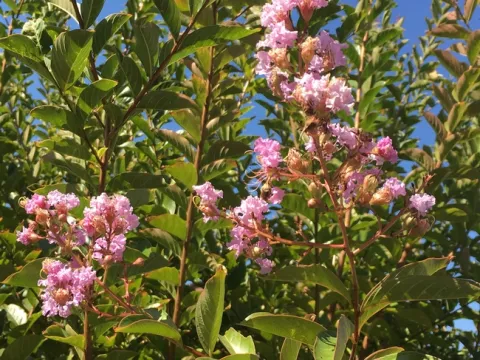
Crape Myrtle
By Leslie Stevens UCCE Master Gardener
Lagerstoemia
Planting area: Sunset zones 7-10, 12-14 and 18-21 (Note: mildew-resistant varieties also grow well in Zone 15)
Size: Varieties of single or multi-trunked trees run 25 – 30 feet tall and wide; shrubs 6 – 20 feet; and dwarfs from 3 – 6 feet.
Bloom season: Summer
Exposure: Full sun
Pruning Needs: Prune annually in late winter or early spring before buds appear to maintain an open center. Also nip off previous year's dried blooms to promote greater flowering in the summer.
Water needs: Low to moderate. Prefers infrequent deep soakings.
Snapshot: Crape Myrtles have been popular in southern states since they were introduced from China in the early 18th Century. They also are planted extensively throughout Southern California and the San Joaquin Valley.
Their widespread popularity is well earned for several reasons. Crape Myrtles' modest size, well-behaved roots, and low water needs fit neatly into small yards, street medians and public spaces.
But they're loved for their beautiful smooth bark and stunning summer flower displays—pendulous clusters of purple, red, pink or white blooms that last for at least a month.
This deciduous tree also puts on a second spectacular show in late fall when its leaves turn shimmering shades of red, orange and yellow. Once the leaves have fallen, crape myrtles show off their marble-like bark in shades of tan or pink-tinged beige.
While crape myrtles are relatively problem free, they are susceptible to aphids. Also, if you are planting in areas with warm and moist climates, make sure to choose varieties that are resistant to powdery mildew and sooty mold.

